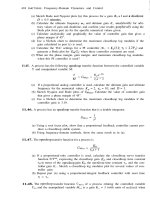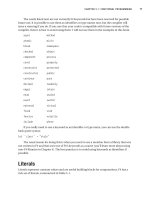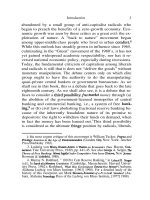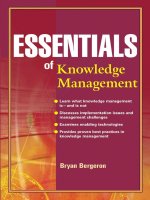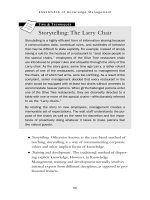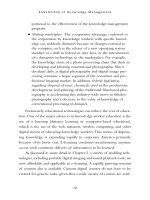ESSENTIALS of Knowledge Management phần 2 ppsx
Bạn đang xem bản rút gọn của tài liệu. Xem và tải ngay bản đầy đủ của tài liệu tại đây (212.84 KB, 23 trang )
Managing information throughout the ages, whether expressed in the
form of figures cut into clay tablets, rows of machines on a factory floor,
or a roomful of cubicles in which service providers handle electronic
documents, entails a web of eight interrelated processes (see Exhibit
1.1). Consider the eight processes in the context of a multimedia pro-
duction company:
1.
Creation/acquisition.
The multimedia—some combination of
images, video, and sound—is either authored from scratch or
acquired by some means. For example, the multimedia company
many create a series of images depicting a new manufacturing
process for a client.
2.
Modification.
The multimedia is modified to suit the immediate
needs of the client. For example, the raw multimedia may be
reformatted for use in a glossy brochure.
3.
Use.
The information is employed for some useful purpose,
which may include being sold and distributed. For example, the
brochure is printed for distribution by the client.
4.
Archiving.
The information is stored in a form and format that
will survive the elements and time, from the perspectives of both
physical and cultural change. The multimedia included in the
brochure may be burned onto a CD-ROM and stored in a fire-
proof safe off site, for example.
5.
Transfer.
The information is transferred from one place to another.
The electronic files of the brochure may be distributed via the
Internet to clients in corporate offices around the globe.
6.
Translation/repurposing.
The information is translated into a form
more useful for a second group of users or for a new purpose.
The images used in the brochure are translated into web-
5
Overview
5
6
ESSENTIALS of Knowledge Management
compatible images to create an online brochure on the client’s
intranet web site.
7.
Access.
Limited access to the translated or original information is
provided to users as a function of their position or role in the
organization. For example, managers in the client’s organization
with the access codes and passwords to the password-protected
web site can view the online brochure that describes the new
manufacturing process.
8.
Disposal.
Information with no future value is discarded to save space
and reduce overhead.When multimedia for a second brochure is
created by the multimedia company, the files relating to the online
and printed brochures are purged from the electronic system.
However, printed and CD-ROM copies of the information are
saved for reference or for the historical record.
In addition to these individual steps, there is an underlying process
for tracking the information in the system. For example, it’s possible for
the original information to be archived while a modified version is
being translated for another purpose.
Given this historical perspective on information, society, and busi-
ness, let’s begin the exploration of contemporary Knowledge Manage-
ment with a definition, a review of KM principles, and a vignette to
illustrate the concepts as they apply to business.
Definition
The Holy Grail of Knowledge Management is the ability to selectively
capture, archive, and access the best practices of work-related knowledge
and decision making from employees and managers for both individual
and group behaviors. For example, a manager may have knowledge of
how to quickly procure parts from a supplier (individual behavior) as
7
Overview
Knowledge Management
in the Field
One of the pioneers in the modern business knowledge manage-
ment arena is the American Productivity and Quality Center (APQC).
For several decades prior to APQC’s 1995 Knowledge Management
Symposium, held in conjunction with Arthur Andersen Companies,
most KM work was conducted in academic laboratories. Much of
this work was performed in specific areas. For example, throughout
the 1980s, research in Knowledge Management in medicine was
carried out in the Decision Systems Group at Harvard Medical School,
with funding from the National Library of Medicine.
Today, many of the Fortune 1000 companies have ongoing KM proj-
ects aimed at general and specific business functions. A partial list
of these companies includes:
I
N THE R EAL WORLD
Air Products & Chemicals Inc.
Allstate Insurance Company
Army Medical Department
Bank of America
Best Buy
BHP Billiton
ChevronTexaco
Corning Inc.
Deere & Co.
Dell Computer
Department of National
Defense, Canada
Intel Corp.
Northrop Grumman
Raytheon Company
Schlumberger Oilfield Services
Shell E&P
Siemens AG
Union Pacific Railroad
Company
U.S. Census Bureau
U.S. Department of the
Navy—Acquisition Reform
Office
U.S. Department of Veterans
Affairs
U.S. General Services
Administration
U.S. National Security Agency
U.S. Naval Sea Systems
Command
U.S. Social Security
Administration
World Bank
Xerox
Xerox Connect
(continues)
well as how to work with other managers in getting policies pushed
through the corporate hierarchy (group behavior).
In practice, most KM practices fall short of this ideal. This is pri-
marily because it’s virtually impossible to capture the thoughts, beliefs,
and behaviors of a manager or employee in a way that is both economical
and complete enough to provide another person—or machine—with
enough quality information to make the same decisions, exhibit the
same leadership principles, or perform the same complex tasks at the
same level of performance. One of the first challenges in understanding
exactly what practical Knowledge Management involves is agreeing on
a definition. Part of the confusion arises because of how the term
“Knowledge Management” is used by vendors who sell products that
have very little to do with the ideal and more to do with relabeling prod-
ucts initially directed at other markets. There is also confusion caused by
terminology borrowed from the academic community regarding the use
of knowledge in artificial intelligence research, much of which doesn’t
apply to Knowledge Management.
This book defines Knowledge Management from a practical business
perspective.
Knowledge Management (KM) is a deliberate, systematic business
optimization strategy that selects, distills, stores, organizes, pack-
ages, and communicates information essential to the business of a
8
ESSENTIALS of Knowledge Management
Within these and other companies, the roles of Knowledge Manage-
ment range from supporting customer relationship management
(CRM) at Xerox to configuring custom computers at Dell Computer.
In addition, there are a numerous KM initiatives in the knowledge-
intensive vertical markets, including medicine, law, engineering, and
information technology.
I
N THE
R
EAL
W
ORLD (CONTINUED)
company in a manner that improves employee performance and
corporate competitiveness.
From this definition, it should be clear that Knowledge Management
is fundamentally about a systematic approach to managing intellectual
assets and other information in a way that provides the company with a
competitive advantage. Knowledge Management is a business optimiza-
tion strategy, and not limited to a particular technology or source of
information. In most cases, a wide variety of information technologies
play a key role in a KM initiative, simply because of the savings in time
and effort they provide over manual operations.
Knowledge Management is agnostic when it comes to the type and
source of information, which can range from the mathematical descrip-
tion of the inner workings of a machine to a document that describes the
process used by a customer support representative to escalate customer
complaints within the business organization. Consider the example of
the legal firm, whose senior partners create written templates (the
information) for ease of creating specific documents. Such a firm has a
KM system that can vastly increase its productivity. If the templates are
moved to a word processing system, then the ease of creating a new
legal document may be enhanced by several orders of magnitude.
As another example, consider a small business owner who moves her
bookkeeping from bound journals to a computerized system. Unlike
the paper-based system, the electronic system can show, at a glance, the
percentage of revenue spent on advertising and revenue relative to the
same period last year—all in intuitive business graphics.
A marketing and communications company that takes all copy and
images that have been used in previous advertising campaigns and digi-
tizes them so that they can be stored on CD-ROM instead of in a filing
cabinet isn’t in itself practicing Knowledge Management. However, if
9
Overview
the company takes the digitized data and indexes them with a software
program that allows someone to search for specific content instead of
manually paging through hundreds of screens, it is practicing Knowl-
edge Management.
Given the range of business activities that can be considered examples
of Knowledge Management, one of the most confusing aspects of the
practice is clarifying exactly what constitutes knowledge, information,
and data. Although the academic community has spent decades debating
the issue, for our purposes, these definitions and concepts apply:
•
Data
are numbers. They are numerical quantities or other
attributes derived from observation, experiment, or calculation.
•
Information
is data in context. Information is a collection of
data and associated explanations, interpretations, and other
textual material concerning a particular object, event, or
process.
•
Metadata
is data about information. Metadata includes
descriptive summaries and high-level categorization of data
and information. That is, metadata is information about the
context in which information is used.
•
Knowledge
is information that is organized, synthesized, or
summarized to enhance comprehension, awareness, or under-
standing. That is, knowledge is a combination of metadata and
an awareness of the context in which the metadata can be
applied successfully.
•
Instrumental understanding
is the clear and complete idea of
the nature, significance, or explanation of something. It is a
personal, internal power to render experience intelligible by
relating specific knowledge to broad concepts.
As shown in Exhibit 1.2, the concepts defining knowledge are related
hierarchically, with data at the bottom of the hierarchy and under-
10
ESSENTIALS of Knowledge Management
standing at the top. In general, each level up the hierarchy involves
greater contextual richness. For example, in medicine, the hierarchy could
appear as:
•
Data
. Patient Temperature: 102° F; Pulse: 109 beats per
minute; Age: 75.
•
Information.
“Fever” is a temperature greater than 100° F;
“tachycardia” is a pulse greater than 100 beats per minute;
“elderly” is someone with an age greater than 75.
•
Metadata.
The combination of fever and tachycardia in the
elderly can be life threatening.
•
Knowledge.
The patient probably has a serious case of the flu.
•
Instrumental understanding.
The patient should be admitted to
the hospital ASAP and treated for the flu.
In this example, data are the individual measurements of tempera-
ture, pulse, and patient age, which have no real meaning out of context.
11
Overview
EXHIBIT 1.2
Understanding
Knowledge
Metadata
Information
Data
Computer
Human
However, when related to the range of normal measurements (infor-
mation), the patient is seen in the context of someone who is elderly
with a temperature and tachycardia. In the greater context of healthcare
(metadata), the combination of findings is viewed as life threatening. A
clinician who has seen this pattern of patient presentation in the past
diagnoses the patient as having the flu (knowledge). In addition, given
the patient’s age and condition, the clinician determines (understanding)
that the patient should be admitted to the hospital and treated for the flu.
Taking an example from a sales agent working for a life insurance
company, the knowledge hierarchy associated with a potential customer
of a life insurance policy could read as:
•
Data.
Marital status: Single; Annual Income: $32,000; Age: 25.
•
Information.
Death risk is greater for single males than married
males; median income is an annual income greater than
$19,000; and “young adult” applies to age less than 25.
•
Metadata.
The prospect represents a moderate to low risk.
•
Knowledge.
Given that the prospect has no dependents, insur-
ance has no value to him unless the policy can be used as an
investment vehicle.
•
Instrumental understanding.
The prospect should be sold a
$100,000 cash value life insurance policy.
In both examples, more than simply grouping data or information
is involved in moving up the hierarchy. Rather, there are rules of thumb
or heuristics that provide contextual information. In the case of life
insurance, the heuristics for risk assignment might be:
•
Low risk.
Age less than 28, marital status single or married.
•
Moderate risk.
Age 28 to 54, marital status married.
•
High risk.
Age 55 or greater, marital status single or married.
12
ESSENTIALS of Knowledge Management
As these risk heuristics illustrate, a challenge in creating heuristics is
guaranteeing completeness and gracefully handling exceptions. In this
case, there is no classification for a 30-year-old single applicant. Similarly,
should a 55-year-old marathon runner be considered in the same high-
risk category as a 75-year-old overweight smoker?
The example also illustrates the contribution of beliefs to knowl-
edge, in that knowledge can be thought of as facts, heuristics, and beliefs.
For example, there may be no basis for assigning married prospects to
the moderate risk category other than hearsay that married men may
live longer than single men. Similarly, in business, there exist beliefs and
prejudices that may or may not be based in reality but nonetheless affect
business decisions. Since these beliefs may be associated with beneficial
outcomes, it’s important somehow to incorporate beliefs in the concept
of business knowledge.
Although the concept of knowledge is roughly equivalent to that
of metadata, unlike data, information, or metadata, knowledge incorpo-
rates awareness—a trait that implies a human, rather than a computer,
host. Although artificial intelligence (AI) systems may one day be capa-
ble of awareness and perhaps even understanding, the current state of
technology limits computers to the metadata level. Even though the
concept of Knowledge Management probably would be better labeled
Metadata Management, the latter term is unwieldy and potentially more
confusing than simply referring to the concept of Metadata Management
as Knowledge Management.
Returning to the wording in the definition of Knowledge Manage-
ment offered earlier, it is important to note that the process is selective,
in that only the important facts and contextual information is saved.
Some sort of filter mechanism must be in place to avoid collecting a
13
Overview
massive amount of information that is too expensive to store and can’t
be easily searched or retrieved efficiently.
Similarly, the KM process involves distillation of data to information
and of information to knowledge. This step further clarifies and limits
the amount of data that must be stored. Before the information can be
stored in some type of memory system, however, it has to be organized
in a way that facilitates later retrieval. Organization usually involves
deciding on a representation language and a vocabulary to identify con-
cepts. For example, in the risk assignment for insurance policy prospects,
does the designation “single” apply to recently divorced prospects as
well? Furthermore, the concept of Low Risk can be represented math-
ematically, as in:
LR = AGE < 28 AND MS = SINGLE OR MS = MARRIED
Or in simple text prose:
Low Risk is assigned to prospective customers less than 28 years
of age who are married or single.
Storage is most often accomplished using several forms of informa-
tion technology, typically including PCs and servers running database
management software. However, data sitting in a repository is of no
value unless it’s put to use. As such, Knowledge Management is a two-
way process, in that data are first captured, manipulated, and stored, and
then the resulting information is packaged or reformatted to suit the
needs of the user. As an example of this packaging, consider the exam-
ple of risk assignment for insurance prospects. The original materials
and process description may be reformatted as a graphical decision tree,
as in Exhibit 1.3.
Similarly, the text originally generated by managers may be simplified
in both organization and vocabulary for easier access by line workers. For
14
ESSENTIALS of Knowledge Management
example, an engineering white paper on calibrating a computer monitor
might state:
The display’s gamma should be adjusted to match the Pantone
145
However, a customer support representative who has to walk cus-
tomers through the calibration process is more likely to understand—
and be able to communicate to the customer—something like this:
The display’s color display curve (see photo) should be adjusted so
that the color displayed on the monitor is as close to the supplied
color patch as possible. . .
This packaging, or formatting, of information in a form most intel-
ligible for its intended consumer can be performed semiautomatically
with software tools such as synonym generators, or manually through
an editorial review process. Finally, for the information to be useful, it
has to be communicated to the intended recipient. Having a wealth of
process and factual data in a sophisticated but dormant information sys-
tem is like having a massive book library and not using it.
15
Overview
EXHIBIT 1.3
Low Risk
Medium Risk
?? Risk
Hi
g
h Risk
Prospect
Age
Married
No
< 28
> 55
28–54
Yes
From the business perspective, Knowledge Management is useful only
if information is used in a directed manner, such as to improve employee
performance. If the information is useful, it should directly impact
employee behavior and be reflected in increased efficiency, effectiveness,
or diligence. Ultimately, the improvement in corporate competitiveness
from the corporate perspective is the rationale for investing in Knowl-
edge Management.
Intellectual Capital
In traditional management of early twentieth century that dealt with
the optimum utilization of labor, parts, and other physical resources,
capital was considered limited to the factories, machines, and other
human-made inputs into the production process. In the modern cor-
poration with a KM initiative, the concept of capital is extended to
include ephemeral intellectual capital and its impact on individual and
organizational behavior. Although intellectual capital can be lumped
16
ESSENTIALS of Knowledge Management
EXHIBIT 1.4
Structural
Capital
Customer
Capital
Human
Capital
into one concept, from a KM perspective, it’s more useful to consider the
constituent components individually, as shown in Exhibit 1.4.
The three major components of intellectual capital are:
1.
Human capital.
The knowledge, skills, and competencies of the
people in the organization. Human capital is owned by the
employees and managers that possess it.Without a KM system in
place, when employees and managers leave the company, they
take their skills, competencies, and knowledge with them.
2.
Customer capital.
The value of the organization’s relationships
with its customers, including customer loyalty, distribution chan-
nels, brands, licensing,and franchises.Because customers often form
bonds with a salesperson or customer representative, customer
capital typically is jointly owned by employee and employer.The
proportion of customer capital held by employees and employers
depends on the relative contribution of customer loyalty to cus-
tomer capital.
3.
Structural capital
. The process, structures, information systems,
and intellectual properties that are independent of the employees
and managers who created them. Intellectual properties are
sometimes considered as a separate, fourth component of intel-
lectual capital.
Each of the three major components of intellectual capital can be
subdivided into finer levels of granularity, as shown in Exhibit 1.5. For
example, for KM purposes, Human Capital is composed of three kinds
of knowledge: tacit, implicit, and explicit knowledge.
Tacit knowledge is knowledge that is ingrained at a subconscious
level and therefore difficult to explain to others. An expert machinist
may be extremely skilled at operating a particular machine, for example,
17
Overview
but be unable to instruct an apprentice on exactly how to duplicate his
expertise. Most knowledge involving pattern recognition skills fall under
the category of tacit knowledge. For example, a seasoned radiologist can
generally look at a typical radiographic film of a patient’s chest and
instantly decide if the film is normal or abnormal. However, eliciting the
process that the expert diagnostician used to make her determination is
virtually impossible.When forced to teach residents and students how to
read radiographic studies, radiologists use a systematic approach, looking
at bones first, then soft tissues, and so on, so that the learner has a place
to start in the learning process. In fact, however, the system most radiol-
ogists teach isn’t the system that they use. Similarly, pathologists, like
master chess players, use one system and teach another.
Implicit knowledge, like tacit knowledge, typically is controlled by
experts. However, unlike tacit knowledge, implicit knowledge can be
extracted from the expert—through a process termed knowledge engi-
neering. For example, an expert at assigning risk to insurance prospects
might use the risk heuristics discussed earlier, assigning risk as a func-
tion of age and marital status. Once a new employee is given the same
heuristics, either in the form of a set of rules or drawn as a decision tree,
he or she can make a risk assignment with the same level of accuracy
as the expert, who may have developed the heuristic through years of
experience.
The third form of knowledge, explicit knowledge, can easily be
conveyed from someone proficient at a task to someone else through
written or verbal communications. The recipe for a cake, the steps
involved in bolting a car door to the main chassis on an assembly line,
and the list of ingredients required for a chemical process are all explic-
it knowledge. Unlike tacit and implicit knowledge, explicit knowledge
often can be found in a book or operating manual.
18
ESSENTIALS of Knowledge Management
Since management in every organization manipulates human,
structural, and customer capital, every organization uses Knowledge
Management to some degree, though not necessarily in a sophisticated,
formalized way. Not only does the relative percentage of the three types
of intellectual capital vary from one company to the next, but the per-
cent of human, customer, and structural capital varies from company to
company, as well.
19
Overview
Intellectual Capital Components
Human
Attitude
Competencies
Education
Knowledge
Skills
Customer
Brand
Company name
Customers
Distribution channels
Franchise agreements
License agreements
Loyalty
Structural
Copyright
Corporate culture
Design rights
Financial relations
Information technology infrastructure
Management processes
Service marks
Trade secrets
Trademarks
EXHIBIT 1.5
The following vignette illustrates the practical value of a formalized
KM approach in increasing corporate competitiveness.
Tale of Two Companies
Two companies at opposite ends of the country, Healthcare Productions
in San Francisco and Medical Multimedia in Boston, are involved in
supporting the pharmaceutical industry. Both companies create promo-
tional materials for conferences, educational programs for clinicians, and
web sites for disseminating prescribing information about drugs to
healthcare providers.
Medical Multimedia, in operation for about five years, has 35
employees and has been operating at a modest profit margin for the past
three years. About half of the employees are involved in creating and
manipulating images, sounds, videos, and other multimedia assets, while
the remainder are concerned with programming, marketing, sales, and
customer support.With two new contracts in the works, and the com-
pany already at capacity due to ongoing projects, Ron, the head of multi-
media production, is operating in panic mode. Multimedia content has
always been created for particular projects; when the project was delivered,
the assets were stored in an ad hoc manner on various company servers,
CDs, and hard drives. The content that was burned onto CD-ROMs
has been stored in a fireproof safe in Ron’s office.
With the deadlines for the two new contracts looming, there is no
time for anyone to excavate for the content previously developed—
some of which could be repurposed for the new contracts. Yet there is
insufficient time to redraw the figures, synthesize the sounds, and render
the video images from scratch. Faced with this reality, Ron approaches
the president of the company and requests permission to hire a multi-
media consultant immediately.
20
ESSENTIALS of Knowledge Management
The president agrees, and Mary, a multimedia consultant with over
20 years experience in the field, is brought on board the next week.
Mary suggests that Ron use a multimedia database program specially
designed to keep track of graphics, sounds, and pictures, and their asso-
ciated intellectual property status, so that components of Medical
Multimedia’s holdings can be quickly and easily repurposed.
With the go-ahead from Ron, Mary lays the groundwork for the
multimedia database program by interviewing everyone who eventually
will directly or indirectly use the system, including:
•
Artists.
Graphic, video, and sound artists who need to refer-
ence prior work or continue work on active projects.
•
Corporate Counsel
. To verify intellectual property status of
individual work. Some images and sounds held by Medical
Multimedia are licensed from third parties for specific purposes
or numbers of users, whereas others are created in house. A
graphic originally licensed for a print publication may need to
be relicensed for use on the web.
•
Management
. Ron and those involved in project management
need to frequently assess the progress of graphic artists and
verify that production schedules are on track.
•
Programmers
. The programming staff needs some way to assess
the technical challenges associated with each media asset des-
tined to be incorporated in electronic products. For example,
some sounds and images may need to be converted into a
form that is compatible with the web.
Not interviewed but considered in the design of the system are:
•
Customers
. Media typically needs to be exported periodically
to customers for their sign-off before the sounds and graphics
are incorporated into the brochures, books, or electronic
products.
21
Overview
•
Potential Clients
. Potential clients who are interested in the
style and quality of artwork may pay the company a site visit
prior to signing a contract for deliverables.
•
Marketing and Sales.
This group uses the media in presenta-
tions to customers and potential customers
In the interview process, Mary is concerned not only with the over-
all process of use but also with exactly how the assets will be cataloged
and then retrieved. For example, she establishes a standard file-naming
scheme that guarantees unique file names. In addition, she creates a
database structure that incorporates the needs of artists, management,
programmers, and corporate counsel that includes:
•
Artist/Licensor
. Name of the creator.
•
Copyright Holder
. The copyright holder of the multimedia.
•
Creation Date
. The date the media was created or acquired.
•
Creation Tool/Version
. Name and version of the software used
to create the asset.
•
File Name
. The full name of the media file, as it appears on
the computer.
•
Index Terms
. Standardized names used to classify the media, in
this case using a vocabulary developed by the National
Library of Medicine for its multimedia holdings.
•
License Expiration Date
. If licensed, the date of expiration.
•
License Restrictions
. For acquired multimedia, the restrictions
imposed by the supplier.
•
Physical Location
.Where the actual multimedia resides in the
company’s information system.
•
Project
. Name of the project the media is intended to support.
•
Source File
. For media rendered from models or other sources,
the name of the source file.
22
ESSENTIALS of Knowledge Management
•
Version
. Version of the file. In the course of editing an image
for production, a dozen or more versions may be created, for
example.
During Mary’s work, she discovers that management has lost touch
with its multimedia assets and its intellectual capital. Other than the per-
son directly involved in managing or creating specific multimedia, no
one knows the specific processes involved in creating products for market.
Management is so focused on company growth through capturing new
contracts that existing processes are being ignored.
For example, one of the company’s core competencies, the ability to
render realistic, three-dimensional (3-D) images of patients, is dependent
on one artist who is fluent in a custom software package that is so spe-
cialized and complex that it takes months to master. Furthermore,
unbeknownst to upper management, Ron has been unable to locate any-
one to hire full time to assist the artist. The best that Ron can do is to
identify a freelance consultant in Seattle and one in Oakland to handle
some of the work. If the in-house artist were to leave, the entire pro-
duction work of the company would come to a halt.
Since Medical Multimedia specializes in custom work, most of the
internal processes parallel those of the artist, in that they are highly person-
dependent and only the creator knows exactly how he performs his
work. Realizing the potential for disaster, Mary approached the president
of the company and suggested that she expand her multimedia asset
management project to include the company’s intellectual capital. Given
her success with the multimedia assets and her experience with similar
companies, the president agreed to extend the asset management project.
He offers Mary a full-time position with Medical Multimedia, in charge
of capturing, cataloging, and managing the company’s multimedia and
intellectual assets.
23
Overview
With assistance from the president, Mary defines a KM program in
which artists, programmers, marketing, and managers are required to
document the process they use in their work, in working with others in
the company, and in interacting with customers. Within a year of being
hired, Mary has a working KM program in place and functioning.
When potential customers call Medical Multimedia for an estimate on
cost and delivery time, sales and marketing are able to quickly and accu-
rately predict the internal cost and time required to create the desired
product. Additional multimedia that must be created or licensed, the
current backlog of work in process, and the additional human resources
needed to complete the project on time are all available to marketing
and senior managers, thanks to the multimedia database and a library of
decision support tools that Mary installed.
Understanding exactly how the 3-D graphic artist performs her
work becomes of particular importance when she suddenly leaves to start
her own company in the Midwest. Thanks to the process descriptions
of her work, Ron is able to hire a replacement with the right mix of
skills and bring him up to speed on the program in only three months.
Within two years, Medical Multimedia is a profitable, 75-person oper-
ation with a record of accomplishment of delivering quality product on
time and to specification.
The San Francisco–based Healthcare Productions, which also
employs 35 employees, takes a different tack regarding the management
of its intellectual capital. Healthcare Productions hires a multimedia
consultant to create a multimedia database to track multimedia assets.
However, the parallels between the two companies stop here.
The president of Healthcare Productions is resistant to extending
the role of the consultant to include intellectual capital. Instead, after six
months of work, the multimedia consultant moves on to another com-
24
ESSENTIALS of Knowledge Management
pany. However, given the competition for artists and programmers in
the volatile economy, employees are constantly leaving the company for
greener pastures. Even with only three or four employees leaving the
company every year, the lag time between finding, hiring, and training
a new employee can be up to nine months. As a result, Healthcare
Productions can’t grow by accepting new clients but is in a holding pat-
tern, simply trying to keep up with the existing demand.
Key Concepts
The story, to be continued in later chapters, illustrates several key con-
cepts regarding knowledge management.
•
Leadership is essential.
Someone in senior management has to
own the KM effort. This manager is often termed the chief
knowledge officer (CKO) if the task is all-encompassing, or
the chief information officer (CIO) or other senior manager
may take it on as an additional responsibility. Regardless of
who takes the role, it involves achieving buy-in at all levels in
the organization. In the story, Mary, who began as a media
organization consultant, became the CIO by default, thanks to
buy-in from senior management.
•
Knowledge Management works.
The potential benefits of
Knowledge Management are numerous and can potentially
benefit every type of business, especially those involved in the
information technology and service industries.What can a
senior manager expect from implementing KM in a corpora-
tion? As illustrated in the story of the two companies, under
optimum conditions, KM promises reduced costs, improved
service, increased efficiencies, and retention of intellectual
assets.
•
Knowledge Management requires training.
Employee and manager
education is fundamental to the proper operation of every
phase of the KM process. As the story illustrates, employees
25
Overview
and managers have to be trained to focus on the overall
process even while they are attending to specific problems.
•
Expectations must be managed.
Implementing a KM program
involves fundamental changes in how employees and managers
interact, communicate, command, and get things done. Before
reporting lines, responsibilities, and management directives
shift to meet the KM demands of the corporation, employees
and managers must be prepared for the change. However, since
most people fear change, especially if it means disrupting a
way of life that they’ve grown accustomed to, productivity can
suffer unless employee expectations are managed proactively.
As Mary’s role in the story illustrates, an effective approach is
to demonstrate the process on a clearly defined, obvious goal
that is an easy win—such as cataloging digital image assets.
Only after this success was the consultant prepared to convince
employees and management of the need to follow general
KM practices.
•
Practical Knowledge Management is technology dependent
. Each
of the steps in the KM process, as well as tracking knowledge
assets, can be enhanced by information technologies. For
example, the process of information creation is supported by
the ubiquitous word processor running on a PC, and painless
acquisition is made possible by the web and associated net-
working hardware. Similarly, storing and manipulating huge
stores of data are made possible by database servers and soft-
ware, and getting data in the hands of users benefits from
handheld devices and wireless networks that provide anytime,
anyplace access to information.
•
Knowledge Management is a process, not a product
. Knowledge
Management is a dynamic, constantly evolving process, and not
a shrink-wrapped product. Knowledge is an organizational
process rather than a static collection of data that can be stored
in a database. Typical KM practices in a modern corporation
26
ESSENTIALS of Knowledge Management
include acquiring knowledge from customers, creating new
revenues from existing knowledge, capturing an employee’s
knowledge for reuse later, and reviewing the predictors of a
successful KM initiative.
27
Overview
Assessing the Value of
Knowledge Management
Before embarking on a Knowledge Management initiative, senior
management should have a good idea of its potential value to their
organization. In other words, what’s wrong with the current model of
conducting business? The key questions to ask are:
•
How would a KM initiative change the day-to-day operation
and management of the organization? For comparative pur-
poses, the operations in companies that make use of KM
techniques are described in Chapter 2.
•
How would employees react to the overhead of a KM system?
Chapter 3 provides a window into the lives of modern
knowledge workers and how KM initiatives impact their pro-
ductivity and relationship to the organization.
•
How much could establishing a KM program improve the
efficiency and effectiveness of the current business
process? Chapter 4 discusses Knowledge Management as
it relates to business processes.
•
What technologies are available for Knowledge Management,
and what are the benefits and limitations? The technological
aspect of Knowledge Management is discussed in Chapter 5.
•
What are the KM solutions offered by vendors, from con-
sulting to hardware and software tools? Chapter 6 explores
the major commercial options available.
(continues)
T
IPS
&T
ECHNIQUES
